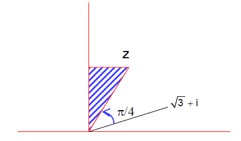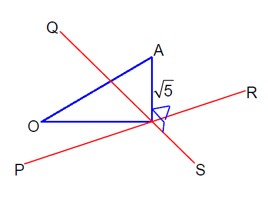Maths
Get insights from 6.5k questions on Maths, answered by students, alumni, and experts. You may also ask and answer any question you like about Maths
Follow Ask QuestionQuestions
Discussions
Active Users
Followers
New answer posted
2 months agoContributor-Level 10
The tangent to the parabola y² = 4ax is y = mx + a/m.
For y² = 4x, a=1. So, the tangent is y = mx + 1/m.
The given line is y = mx + 4.
Comparing the two, 1/m = 4 ⇒ m = 1/4.
The line is y = (1/4)x + 4.
This line is also tangent to x² = 2by.
Substitute y into the parabola equation:
x² = 2b (1/4)x + 4)
x² = ( b/2 )x + 8b
x² - ( b/2 )x - 8b = 0.
For tangency, the discriminant (D) is zero.
D = (-b/2)² - 4 (1) (-8b) = 0.
b²/4 + 32b = 0.
b ( b/4 + 32) = 0.
b = 0 (not possible) or b/4 = -32 ⇒ b = -128.
New answer posted
2 months agoContributor-Level 9
(3¹/? + 5¹/? )?
General term =? C? (3¹/? )? (5¹/? )? =? C? 3^ (60-r)/4) 5^ (r/8)
Terms are rational for r being a multiple of 8 and (60-r) being a multiple of 4.
If r is a multiple of 8, then 60-r is 60 - 8k. Since 60 is a multiple of 4, 60-8k is also a multiple of 4.
So, we just need r to be a multiple of 8.
r = 0, 8, 16, 24, 32, 40, 48, 56. (Total 8 rational terms)
Total terms are 61.
Number of irrational terms = 61 - 8 = 53 = n.
∴ n - 1 = 52.
New answer posted
2 months agoContributor-Level 10
g (f (x) = f² (x) + f (x) - 1.
g (f (5/4) = f² (5/4) + f (5/4) - 1.
Given g (f (5/4) = 5/4, let f (5/4) = y.
-5/4 = y² + y - 1 (There appears to be a typo in the image's solution)
y² + y - 1 + 5/4 = 0
y² + y + 1/4 = 0
(y + 1/2)² = 0
y = -1/2.
So, f (5/4) = -1/2.
New answer posted
2 months agoContributor-Level 10
A = 1/3 [ 1; 1 ω ω² 1 ω² ω ]
A² = A * A = 1/9 [ . ]
(The calculation in the image shows A² is the identity matrix, let's verify)
A² leads to I (Identity matrix).
So A² = I.
A³ = A² * A = I * A = A.
A? = (A²)² = I² = I.
A³? = (A²)¹? = I¹? = I.
New answer posted
2 months agoContributor-Level 10
y = √ (2cos²α / (sinα cosα) + 1/sin²α)
y = √ (2cotα + cosec²α)
y = √ (2cotα + 1 + cot²α) = √ (1 + cotα)²) = |1 + cotα|.
Given α is in a range where 1+cotα is negative, y = -1 - cotα.
dy/dα = - (-cosec²α) = cosec²α.
At α = 5π/6, dy/dα = cosec² (5π/6) = (1/sin (5π/6)² = (1/ (1/2)² = 2² = 4.
New answer posted
2 months agoContributor-Level 10
Given Re (z-1)/ (2z+i) = 1, where z = x + iy.
(z-1)/ (2z+i) = [ (x-1) + iy] / [2x + I (2y+1)]
To rationalize, multiply the numerator and denominator by the conjugate of the denominator [2x - I (2y+1)].
Numerator = [ (x-1) + iy] * [2x - I (2y+1)] = 2x (x-1) - I (x-1) (2y+1) + i2xy + y (2y+1)
Real part of the numerator = 2x (x-1) + y (2y+1).
Denominator = (2x)² + (2y+1)².
Re (z-1)/ (2z+i) = [2x (x-1) + y (2y+1)] / [ (2x)² + (2y+1)²] = 1.
2x² - 2x + 2y² + y = 4x² + 4y² + 4y + 1.
0 = 2x² + 2y² + 2x + 3y + 1.
So, 2x² + 2y² + 2x + 3y + 1 = 0.
New answer posted
2 months agoContributor-Level 9
dy/dx + 2y tan (x) = sin (x)
I.F. = e^ (∫2tan (x)dx) = e^ (2ln (sec (x) = sec² (x)
Solution is y sec² (x) = ∫sin (x)sec² (x)dx = ∫sec (x)tan (x)dx
⇒ y sec² (x) = sec (x) + c
y (π/3) = 0 ⇒ 0 * sec² (π/3) = sec (π/3) + c ⇒ 0 = 2 + c ⇒ c = -2.
∴ y = (sec (x) - 2) / sec² (x)
Now let g (t) = (t - 2)/t² = 1/t - 2/t² for |t| ≥ 1.
g' (t) = -1/t² + 4/t³
g' (t) = 0 ⇒ t = 4.
g' (t) = 2/t³ - 12/t? g' (4) < 0, hence maximum.
∴ g (t)max = g (4) = (4 - 2)/4² = 2/16 = 1/8.
New answer posted
2 months agoContributor-Level 10
The equation of the line is (x-2)/1 = (y-1)/1 = (z-6)/-2.
Let this be equal to k. So, a point on the line is (k+2, k+1, -2k+6).
This point lies on the plane x + y - 2z = 3.
(k+2) + (k+1) - 2 (-2k+6) = 3
2k + 3 + 4k - 12 = 3
6k - 9 = 3
6k = 12 ⇒ k = 2.
The point of intersection is (2+2, 2+1, -2 (2)+6) = (4, 3, 2).
New answer posted
2 months agoContributor-Level 9
PR (line): r = (3i - j + 2k) + λ (4i - j + 2k) - (I)
QS (line): r = (i + 2j - 4k) + μ (-2i + j - 2k) - (II)
If they intersect at T then:
3 + 4λ = 1 - 2μ
-1 - λ = 2 + μ
2 + 2λ = -4 - 2μ
Solving the first two equations gives λ = 2 & μ = -5. These values satisfy the third equation.
∴ T (11, -3, 6)
Also, OT is coplanar with lines PR and QS.
⇒ TA ⊥ OT
|OT| = √166
|TA| = √5
|OA| = √ (|OT|² + |TA|²) = √171
Taking an Exam? Selecting a College?
Get authentic answers from experts, students and alumni that you won't find anywhere else
Sign Up on ShikshaOn Shiksha, get access to
- 65k Colleges
- 1.2k Exams
- 679k Reviews
- 1800k Answers


